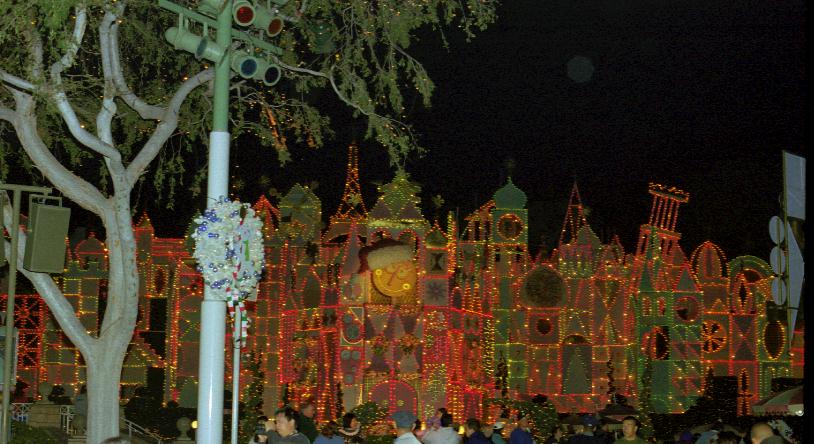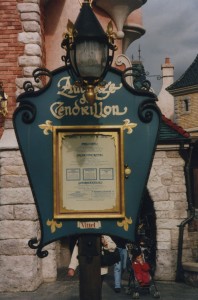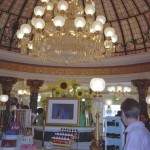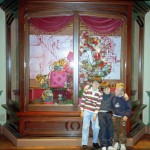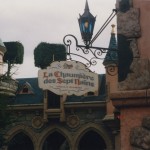It’s a Small World, at night.
When Disneyland Paris, then called Eurodisney, opened its doors, there was a real possibility that it would flop, that Europeans, and in particular the French, would not take to it.
The French have a definite dislike for Americans, or at a minimum a strong reserve as far as we’re concerned. They have boycotted McDonald’s a fair bit over the years, are in a constant battle to protect the French language from anglicized incursions, and complain constantly about US commercial and cultural hegemony.
My theory is that underneath it all they bitterly resent those who came to their rescue during the Second World War. The French are a people defined by their pride. It must have driven them crazy first to suffer defeat at the hands of the Germans and then, even worse, to have been rescued by us anglo-saxon hicks. Général Leclerc’s free French forces participated in the invasion after D-day, of course, but the US ran the show, and contributed the most in men and machines, followed by the UK and Canada. How do you forgive those who, by their courage, shamed you?
EuroDisney opened its doors in an anti-American country, touting its wares to an anti-American people.

Check out this beanstalk, the branch that enters the turret though the lower window, and leaves it through the upper window! Daphné and Alban check it out while their maman looks away.
I watched how the story played out in a microcosm around our family. We all went together in September or October 1994 for our first visit, a couple of months after we moved in together. Marie-Hélène went because she was interested and because it would likely be fun for the children. She approached the place with typical French reserve, as ready to be disappointed as she was to be pleased.
I had no idea at all which way she would go, whether she would take to it or not. Having spent some lovely times already at Disneyland in Anaheim, I did know how American it was.
Then I heard her talking to her father over the phone, and telling him what wonderful décor she had seen there. He had to go visit the park himself, she told him, so that he could see it for himself. Decorous things are pretty central to Marie-Hélène and her family: her mother had been a painter, her father a professional photographer, and Marie-Hélène herself loved pretty objects and trinkets. It was only looking at Disneyland in Paris through her eyes that I realized how beautifully done it all was.
Parc Asterix, a French-themed park, had surfed the Disney wave by opening its doors a year or two before Disneyland opened its. The French loyally checked it out, once or twice, as did we.
The Asterix décor flopped. The theme was suitably French, the adventures of Asterix, Obelix, Getafix the Druid and Cacofonix the Bard, French comic characters whose tales of beating Ceasar’s legions against all the odds have spread across the anglo-saxon world from the francophone world. But the decoration was sad, especially compared to Disney.
Most of the photographs on this page were taken at Disneyland Paris one blustery fall day in 1995. Marie-Hélène wrote her own captions on the back of many: things like “une enseigne à Disneyland” ( a sign) and “une place à Disneyland” (a square). The park is decorated to the hilt. None of the cheap corner-cutting that often characterizes its competitors, like Parc Asterix.
I think that the Paris Disneyland is the best decorated of the three which I have visited. In part, this is because it is the most recent. But also, the Disney people were smart enough when they brought their happy place to France to make an extra effort there. They talked publicly about paying particular attention to Sleeping Beauty’s castle in a country with its own real castles. I think that they did the same with all of the decor. The craftsmanship and imagery are simply superb.
- An intricate vertical sundial
- A store on Main Street sports this wonderful chandelier
- A storefront on Main Steet
- In the arcade behind Main Street, Nick, Tom and Alban in front of a beautiful window.
- A barber’s shop on Main Street
- “Vente de hot dog”
- The Seven Dwarfs’ casserole
- A Pirate of the Caribbean, before Johnny Depp got involved!
- Excalibur was pretty attractive to our little band.
Here are the rides, and the residents, and the main Disney page.
Here are kids fooling around, a risky flight, a chateau in a town in Brittany, and a little boogie-boarding.


